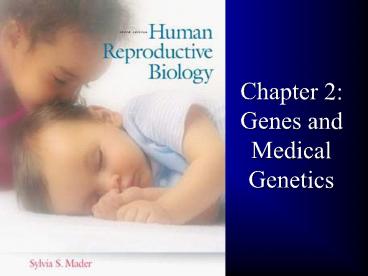Chapter 2: Genes and Medical Genetics - PowerPoint PPT Presentation
1 / 23
Title:
Chapter 2: Genes and Medical Genetics
Description:
This time we'll consider genetic and there impact on how we 'look,' and what ... Basic Mendelian Genetics. and the Punnett Square. If we 'cross multiply,' it ... – PowerPoint PPT presentation
Number of Views:72
Avg rating:3.0/5.0
Title: Chapter 2: Genes and Medical Genetics
1
Chapter 2 Genes and Medical Genetics
2
Introduction
- So far, its been all about the cell.
- Last lecture we examined how cells divide. A
process which facilitates life. - This time well consider genetic and there impact
on how we look, and what potential pitfalls may
occur when cell division and replication dont
give us what we wanted.
3
Introduction
- As always we have several new terms.
- Genotype genes of the individual. Your genetic
makeup, if you will. - Phenotype What you look like, or more precisely,
what physical manifestations are observed. - Allele Alternate forms of a gene which are
located in the same position on a pair of
chromosomes.
4
Fig. 02-01
- Three paths
- Two results??
- Not really!
- Again, new terms
- Dominant allele
- (capital letter)
- Recessive Allele
- (lower case letter)
5
- As you can see during
- meiotic cell division, alleles
- are isolated within each
- gamete.
6
- How do alleles (genes) get mixed up??
- Rem Meiosis? Crossing over??
- Alleles are spread around in an amazing way
during sexual reproduction. - As we will see, this leads us to some
interesting results which dont always seem
logical.
7
- Alleles on autosomes
- Basic Mendelian Genetics
- and the Punnett Square
- If we cross multiply, it
- becomes evident that not
- all genotypes result in the
- same phenotype.
- The example at the left is a
- single-trait cross.
- Notice the expected
- phenotypic ratio (31).
- This will become important
- later.
8
- What happens if we
- mix it up a bit??
- Same method, different
- results.
- Now the phenotypic
- ratio is 5050 (Better odds
- than youd get in Vegas!)
9
- Okay, Emiril, lets
- Kick it up a notch!!
- Dihybrid crosses
- (and beyond) are
- handled similarly.
- You must be careful
- to transfer all your
- alleles though!!
- Once this is done,
- figuring out what
- you have can be
- challenging.
10
Genetic Disorders
- Most of the time, genes are expressed and
individual live quiet lives. - Sometimes two alleles get together that
shouldnt! - Many are autosomal dominant and expressed with
alarming frequency. - In the case of autosomal dominance, even
heterozygotes express the phentype.
11
Genetic Disorders Autosomal Dominant
- Disease Occurence Symptoms
- Neurofibromatosis 1/3500 Dark Spots
- Huntington ?? Neuopathy
- Polycystic Kidney Nephretic cysts/
hypertension - renal failure
12
Genetic Disorders Autosomal Recessive
- Disease Occurence Symptoms
- Cystic Fibrosis 1/2500 bronchial mucus
- clogged pancreatic ducts
- Phenylketonuria 1/5000 high urinary phenylalanine
concentration - Tay-Sachs ?? Blindness, paralysis, death
13
(No Transcript)
14
- Polygenic Inheritance
- Height, skin color, etc.
- The absolute reason for
- expression of some traits
- such as a persons height
- can be nebulous.
- Many alleles dictate the
- height of an individual, so
- just because your dad
- was 7 doesnt mean you
- will be (though it doesnt
- hurt either).
15
Some traits share an additional genetic
component, despite differing environmental
factors
16
- Multiple Allelic Traits
- Blood types are coded
- for by three different
- alleles.
- Codominance exists
- because A and B are
- dominant over O.
17
- Incomplete dominance
- Paul Mitchell aside,
- hair curls, or lack of
- them are expressed
- as a mixture of straight
- vs. curly locks.
- What can result is a
- continuum of hair curls,
- waves and looks.
18
- Incomplete dominance is also observed in
- Sickle-cell Disease. Here homozygotes (HH)
are normal, - heterozygotes (Hhs)are carriers, and
recessives (hshs) - have the disease. Oddly enough, carriers are
superior in - certain environments due to Malaria resistance
conferred - by the Sickle-cell trait.
19
- Sex-linked traits
- Occur when alleles are
- located on sex chromosomes.
- Sex-linked traits can be harsh.
- Ex. Muscular distrophy
- Hemophilia
20
Fig. 02-14
Muscular Distrophy
21
Fig. 02-15
Sex-Influence Traits
22
Fig. 2D
23
Fig. 2C































